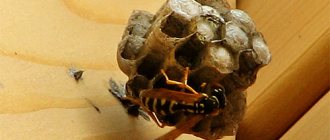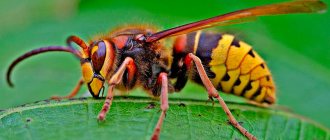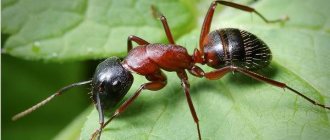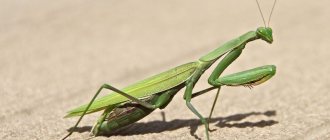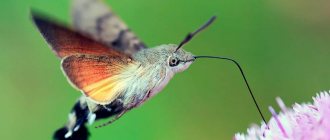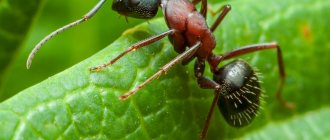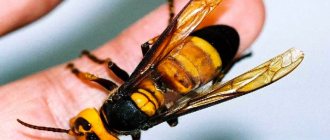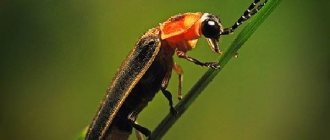- Wild animals
- >>
- Insects
Anyone who is at all interested in the origin of the animal world on earth knows that the carpenter bee is one of the most ancient insects on our planet. Scientists date their appearance long before the appearance of humans - 60-80 million years ago. And at the end of the 20th century, in one of the mines in the north of Burma (Myanmar), a prehistoric insect of this species was discovered, frozen in a drop of amber. And just think about this find! – about 100 million years.
Origin of the species and description
Photo: Carpenter Bee
The taste of honey was familiar to primitive man. Along with hunting, ancient people also collected honey from wild bees. Of course, honey made up a small part of the diet of our distant ancestors, but it was the only source of natural sugar known in those days.
The appearance of honey bees is inextricably linked with the appearance of flowering plants on Earth. It is assumed that the first pollinators were beetles - insects even more ancient than bees. Since the first plants did not yet produce nectar, the beetles ate their pollen. With the advent of nectar, the evolutionary process of insects came to the stage of the appearance of the proboscis, then to its lengthening and the appearance of the honey crop - a container for absorbing nectar.
Video: Carpenter Bee
It was then that the higher hymenoptera appeared - the most ancient ancestors of modern honey bees. They swarmed, gradually mastering more and more new territories. They developed an instinct to return to flowers of the same species for pollination, and this was very important for the evolution of flowering plants. Over such a long period of existence, many varieties of bees have arisen, and currently scientists have systematized more than 20 thousand species of these insects.
One of the largest members of the honey bee family is the carpenter bee. Scientific name: Xylocopa valga. The insect owes its name “carpenter” to its own way of life, and in particular to the way it builds nests. With the help of powerful jaws, the bee gnaws tunnels in the wood, arranging nesting sites there.
The carpenter bee is twice the size of its closest cousins and does not have the characteristic yellow and black striped color. In addition, these insects do not swarm and are classified as solitary bees.
Tunnel shape
The bee drills a hole in the wood 2-3 cm deep and 1 cm in diameter. From the hole the tunnel turns to the side - it will go along the fibers. Inside the tunnel are chambers containing brood, pollen and nectar.
Tunnel in the bush
When searching for nests, keep the following in mind:
- Xylocopa bees are only interested in dry wood;
- There is always one entrance in the tunnel;
- Unlike ants, bees do not eat fiber. So you can find the tap hole by looking at shavings and sawdust.
By the way, the wood should be soft. Birch, oak, beech and ash are not suitable.
If the tree does not dry out, carpenter bees cannot nest in it. Pillars and old buildings made of wood are a more suitable substance.
Habitat, number of generations
There are two types of bees common in the Russian Federation – “ordinary” and “purple”:
- Valga are large bees with a body length of up to 30 mm! The hairs on the abdomen are sparse and black. Wings with blue glitter. Range - from the Leningrad region to Tatarstan, including the Middle and Southern Volga region.
- Violacea – medium body size. The habitat is almost all southern regions.
The Valga bee lives throughout most of Eurasia. It, like the insects Xylocopa Violacea, was included in the Red Book.
Species Xylocopa Valga
Two more interesting species are Virginica, that is, the Virginia woodworm, and Xylocopa Latipes. The latter species lives in the tropics.
The habitat always depends on physiology, as well as on the method of arranging nests: in winter it will be cold in a wooden dwelling.
The habits of the “common bee” were studied in Russia:
- The female builds a communal and sometimes solitary nest;
- There will always be bends in the tunnel;
- Loose wood with fungus can serve as a place of settlement;
- One generation appears every year. The characteristic number for the species Latipes is 2, for Virginica – 1.
Each female lays several dozen eggs in spring and summer, from which young individuals subsequently hatch. By autumn, the brood will be mature - ready for wintering, awakening and reproduction. Life expectancy exceeds a year.
Life cycle
Dry, dead wood will always rot. One nest of Valga bees can last 6-8 years. Then it will be abandoned.
Entrance in the tree
In the spring, the scenario develops like this:
- The bees awaken, but one of the females will lay eggs in a single nest. The remaining bees must create new nests.
- Laying is done after mating. The embryos of females end up in distant cells.
- After laying, the nest will be guarded by the mistress, and in the fall it will be sealed.
When laying is done, pollen and nectar are needed. At this time, the female can travel long distances for food.
For the Valga species, the limit will be 5 km, and honey bees fly 11 km from the hive. However, the standard distance in apiaries does not exceed a kilometer.
The life of a Xylocopa Valga nest is not very interesting to observe:
- The larvae develop for 21 days, then they begin to pupate. At this time, one female is guarding.
- In August, young individuals gnaw passages from the chambers, go outside and fly around. Then the males die, and the fertilized females spend the winter.
- Another scenario: in September the nest is sealed and the mistress flies off. Young, recently hatched individuals or even cocoons overwinter.
In regions where it is not very hot, the process follows the second scenario. Individual bees spend the winter in chambers, and in the spring they come out.
Tunnel and new entrances
It turns out that in winter you can only find an abandoned nest.
Appearance and features
Photo: Insect bee carpenter
Appearance is what immediately distinguishes the carpenter bee from all other representatives of the species. Firstly, the insects are very large; females can reach 3-3.5 cm in length. Males are slightly smaller - 2-2.5 cm.
Secondly, the head, chest and abdomen of carpenter bees are completely black, shiny, no yellow-black stripes, like ordinary bees. Almost the entire body is covered with thin purple hairs. They are absent only on the abdomen. The wings are rather small compared to the body, transparent and as if dissected at the edges. Thanks to this structure, their blue-violet tint is very pronounced.
Interesting fact: it is because of the color of their wings that people divide carpenter bees into blue and purple. However, no other differences, with the exception of color, were identified in these two categories, so this division is considered not scientific, but philistine.
Females differ from males not only in size, but also in some other parameters. So, for example, females have a sting, longer antennae with red patches, protruding teeth can be seen on their hind legs, and the color of the villi covering the body is exclusively dark purple, while in males it can have a brown tint.
The eyes of carpenter bees have the same faceted structure as those of most insects. They are located on both sides of the head. In addition, there are three additional pinpoint eyes on the crown of the bee.
In order for the carpenter bee to cope well with its activity - gnawing wood - nature carefully endowed it with a durable skull with chitinous partitions and powerful jaws. And these, of course, are the main features that distinguish this type of insect from its closest relatives - ordinary honey bees.
Habitat area
There are more than 20,000 species of industrious insects throughout the Earth. They come in white, blue, gray, etc.
The habitat of black bees is located almost throughout the globe, excluding areas with a cold climate that does not have a summer season. Bumblebees tolerate wintering well even at very low air temperatures, but they can carry out a full life process only during the warm period.
The habitat of these insects extends throughout all countries, excluding regions with a perpetually cold climate.
It is interesting to know that some breeds of dark individuals can be domesticated and tolerate transportation well. Therefore, if desired, every beekeeper can acquire rare pets.
The black bee is a popular representative of a separate species of common insects. But over time, their numbers began to decline sharply, so they were registered as a rare endangered species. Honey plants bring great benefits - they continuously pollinate flowering plants and clean the air. Preserving the current population is an international task that all people should help solve.
Where does the carpenter bee live?
Photo: Common carpenter bee
Since their appearance on our planet, bees have mastered a fairly extensive geography. They left their parents' nests and rushed to new territories. Bounded to the north and east by the Himalayas and to the south by the ocean, ancient bees are thought to have headed west.
They first reached the Middle East and then began to occupy the territory of Egypt. The next stage of development was the northern coast of Africa, then the swarms reached the Atlantic and further to the Iberian Peninsula.
And they came to the territory of our country from Central Europe, spreading all the way to the Urals. The Ural Mountains turned out to be an insurmountable obstacle for honey bees. The climate of those places is very harsh, and the dark coniferous taiga did not allow the bees to count on an abundance of food. Honey bees failed to penetrate into Siberia and the Far East.
But this is all history and the natural distribution of the species. Of course, now the habitat of honey bees is much more extensive, and people have taken care of this. Along trade routes, sea and land, bees were brought to America and Mexico, and then to Australia and New Zealand.
For the carpenter bee, the main habitats are still Central and Western Europe and the Caucasus. As for Russia, here the species is distributed in the most comfortable living conditions. These are the Krasnodar Territory and Stavropol Territory, the Middle and Lower Volga, the Central Black Earth Region and other territories with a similar climate.
What does a carpenter bee eat?
Photo: Carpenter Bee Red Book
The diet of carpenter bees is practically no different from what ordinary bees eat:
- nectar;
- pollen;
- beebread;
- honey.
First of all, this is, of course, nectar and pollen of flower plants - the main food from spring to autumn. In addition, bees eat bee bread (also called bee bread) and their own honey. The most preferred treat for the carpenter bee is acacia and red clover pollen. But in general, they pollinate more than 60 species of honey plants.
If you take a closer look at the carpenter bee’s menu, you can identify several important components. So, for example, in order for the bee body as a whole to be strong and efficient, insects eat nectar and honey - generous natural sources of carbohydrates.
Pollen is the source of protein for bees. It helps keep their endocrine and muscular systems healthy. When collecting pollen, bees moisten it with saliva and nectar so that it gets wet, sticks together a little and does not crumble during long flights. At this moment, thanks to the secretion of the bee and the properties of the pollen itself, the process of pollen fermentation occurs, as a result of which beebread is formed.
Adult and young bees feed on beebread. They also use it to turn it into pulp and/or royal jelly, necessary for feeding the larvae, with the help of the secretion of the jaw glands.
Features of character and lifestyle
Photo: Carpenter Bee
Despite its impressive size compared to its closest relatives, the carpenter bee does not pose a threat to any creature in nature. These insects are absolutely not aggressive. Of course, the female carpenter can use her only weapon - a sting, but she does this exclusively for self-defense or in case of real danger to her life.
However, the amount of venom injected into a carpenter bee sting is quite large and causes widespread, painful swelling. But if you don’t try to attack the bee’s home and don’t tease her, then she most likely won’t even pay attention to anyone’s presence. She already has enough worries.
All bees are hard workers by nature, but the carpenter bee is a true workaholic. True to its nickname, it makes deep tunnels in old and rotten wood. It can be anything - outbuildings, all types of rotten boards and logs, dead wood, stumps, old trees. Soft wood easily yields to the pressure of powerful bee jaws, and multi-level dwellings appear inside it, in which the larvae will then live and develop.
Interesting fact: the carpenter bee prefers only natural wood. If the surface is painted or treated with protective and decorative compounds, these gourmets will not be interested in it.
The process of gnawing out a tunnel is quite noisy; the bee makes a sound similar to the buzzing of a miniature circular saw. This sound can be heard several meters away. As a result of the efforts made by the carpenter bee, a perfectly round entrance to the nest and internal multi-level passages up to 30 cm deep are formed.
The carpenter bee is not a swarming bee. These are solitary insects. Each female organizes her own colony. Bee activity lasts from May to September, and under favorable weather conditions – until October.
How to get rid of wood bees in the wall of a wooden house using a gentle method
Black shemale
Few disinfection services will deal with black bees, as it is illegal. Therefore, the question of how to get rid of tree bees on your own becomes especially relevant. Given the circumstances, the only way to get rid of insects is through sound vibrations.
The woodcutter bee is very sensitive to noise. It is enough to turn on loud music near the proposed housing. Preferably a composition with low frequencies - high-quality bass. Blue bees will leave their wooden home on their own.
Drive away bees with low-frequency music
There is a more aggressive, but effective method.
Remedy for blue bees
How to deal with tree bees if noise does not help?
The easiest way to protect your home from these insects is with sticky traps for flying insects. But it is effective for single catching.
In addition to this, there are other means:
- If the pests are very annoying and pose a real danger to the health of the household, you can sacrifice one generation of them to ensure that they are not in the old holes forever. To do this, you need to fill the entire socket through the main passage with an aerosol carburetor cleaner or ordinary gasoline. At the same time, it is worth remembering safety measures with such toxic substances, especially when it comes to working with wood.
- Special pesticides, especially powder ones, are quite effective in destroying homes. The most commonly used are boric acid or carbaryl.
Important! The individuals themselves are not aggressive. If the carpenter wasp does not feel a threat to its life and the integrity of the “house”, it will not attack.
Social structure and reproduction
Photo: Insect bee carpenter
Unlike ordinary honey bees, the carpenter bee family is not divided into queens, workers and drones. There are only females and males here. But, like all insects of this species, absolute matriarchy reigns among carpenters. This hierarchy is due to the fact that the main work of creating a colony, feeding and raising larvae falls on the female.
Males are not so hard-working, and their function is mainly to fertilize females. During the breeding season, males are very actively attracted to them. Seeing a suitable bee, the male takes a position on some hill and buzzes loudly, trying to attract her attention.
If the female does not show proper activity and does not leave the nest, then the gentleman himself descends into her hiding place and continues “courtship” until the chosen one reciprocates his feelings. Males are polygamous, each of them guards his own small “harem”, which is inhabited by 5-6 females.
When setting up a nesting site, the female places pollen at the bottom of the tunnel and moistens it with nectar and her own saliva. She lays an egg in the resulting nutrient mixture. From the sawdust left after gnawing the tunnel and glued with saliva, the bee creates a partition, thereby sealing the cell with the future larva located in it.
The nutritious nectar mixture is again laid on the formed partition, another egg is laid and the next cell is sealed. Thus, the bee fills the entire tunnel and moves on to a new one. As a result, the carpenter bee's nest acquires a multi-story and branched structure.
Interesting fact: the homes of carpenter bees can rightfully be called “family nests”, since they can be used by many generations of individuals.
Having laid her eggs, the female watches and guards the nesting site for some time. Most often, adult females die during the winter cold, but if they manage to survive the winter, then next spring they begin a new cycle of breeding.
The larvae grow and develop independently. By the end of summer they pupate, and by the beginning of winter the cells are inhabited by young bees, who are forced to remain locked up until they gain enough strength.
In the spring, fully grown, strong individuals gnaw their way to freedom and rush in search of nectar. Their independent life begins, they begin to build their own nests and breed new colonies.
Socket device
The female founder lays a batch of eggs in the spring in a secluded place of her choice among the stones. She takes care of her first offspring herself. After a few weeks, the younger generation is already helping her. When the number of rock bumblebees exceeds the first hundred, the female stops flying out of the nest and only lays eggs.
Working females collect nectar and beebread to replenish the hive's supplies. They have a long proboscis, which is adapted for collecting the sweet liquid of the inflorescences. Drones build new cells to breed their young and to store processed nectar known as honey. Males do not collect flower sweets and do not participate in plant pollination.
Bumblebee honey is not inferior in taste and healing qualities to bees. But it is inferior in quantity, since the lifespan of hairy insects is only a few months and there is no need to make large reserves of food.
Natural enemies of carpenter bees
Photo: Common carpenter bee
Thanks to their impressive size and durable wooden homes, carpenter bees have far fewer enemies in the wild than regular honey bees. First of all, these are, of course, insectivorous birds - bee-eater, shrike, golden bee-eater and many others.
Danger awaits carpenter bees in the habitats of frogs. They feed on different types of insects, but do not mind eating a bee, grabbing it in flight with their long sticky tongue. Another predatory representative of lovers of these insects is the spider. It weaves its web in the immediate vicinity of bee nests and catches unwary bees with it.
No less dangerous for carpenter bees are their distant relatives such as hornets. They are twice as large, very voracious and can destroy bees in large numbers for their own food.
Another natural, although not the most dangerous, enemy of the carpenter bee is dragonflies. They do not always attack, especially against such large representatives of bees. They prefer easier prey. However, in those years when dragonflies breed too actively, there is not enough food, and carpenter bees end up in their diet along with other insects.
And in the immediate vicinity of the surface of the earth, carpenter bees lie in wait for mice and other insectivorous rodents. Most of them are not able to reach the nests of carpenter bees and destroy them, as they do with the hives of ordinary honey bees, but adults quite often end up with these small predators for lunch. Since carpenter bees are not tamed or domesticated by humans, they do not have to wait for help in the fight against natural enemies.
Recommendations for stinging insect bites
- If the sting remains in the body, you need to pull it out with treated tweezers. There is no need to try to squeeze it out with your fingers, so as not to infect the victim.
- The wound should be immediately treated with hydrogen peroxide, alcohol, vinegar, or cotton wool soaked in one of the listed products.
- Apply a piece of ice or a cold compress to the bite site, especially if it is around the eyes or other sensitive area. Cold will relieve swelling, reduce pain and slow down the absorption of poison. To extract the poison, you need to apply a piece of sugar moistened with water to the damaged area.
- The victim should be given plenty of liquid to drink, preferably hot tea with sugar. If the victim does not get better, or symptoms of an allergic reaction appear, then you should immediately call a doctor.
https://youtube.com/watch?v=dWlWKRx5v3A
Treatment of insect bites at home
In most cases, a bumblebee bite can be safely treated at home. For example, you can put a fresh leaf of plantain or parsley on the injured area and replace it with a new one every 2 hours.
You can apply a chopped onion, apple, raw potato to the damaged area, or chop 2 cloves of garlic, mix with honey and attach this mixture to the bite. The bandage must be changed twice a day.
Lemon juice and a compress made from it will also help.
Bumblebee sting
You can also dilute baking soda with water until a slurry forms and apply to the affected area, or prepare a solution of soda (1 teaspoon per glass of water), soak cotton wool in it and apply for a quarter of an hour.
Grind the activated carbon, add water until a paste forms, place it on the bite site and cover with film to prevent rapid drying.
If there is no activated carbon, apply validol moistened with water to the damaged area. You can also use medications, for example, Fenistil gel, which successfully relieves irritation. The damage should be lubricated with gel 3 times a day. The medicine begins to act immediately after application. If you are bitten by insects, you should not drink alcohol, as this leads to increased swelling.
Often people unwittingly provoke insects by waving their hands, trying to drive them away. This behavior, as well as the smell of perfume, alcohol, and fried meat, only attract and irritate bumblebees.
The smell of perfume attracts bumblebees
When should you go to the hospital?
- If several bumblebees or bees were bitten at the same time.
- When a child or elderly person is injured.
- If the bite occurs in the eyeball or mucous membrane of the mouth.
- When previous insect bites caused an allergic reaction.
- There are symptoms of infection: severe chills, swelling, pain, the bite site becomes purulent.
When a bumblebee bites, it is less painful than a bee or wasp sting because its venom is not as dangerous as that of a bee or wasp. In addition, a wasp can bite several times.
bumblebee nestConclusion on the topic
Knowing that bumblebees bite, do not provoke these insects. Try to avoid the places where their nests are located. Where bees, bumblebees or wasps are present in large numbers, it is undesirable to eat sweets, watermelons, melons, and drink sweet drinks.
Although bumblebees bite, there is no need to destroy them, because they pollinate plants well, and their honey contains protein, sucrose, many minerals and is very healthy.
A black insect similar to a bumblebee can be seen rarely - the species is listed in the Red Book as declining in numbers. The black bumblebee, or carpenter bumblebee, is actually the largest bee.
Population and species status
Photo: Insect bee carpenter
Despite the fact that the importance of the presence of bees in the wild is difficult to overestimate, their populations are constantly and steadily decreasing.
There are several reasons for this:
- increasing the amount of farmland;
- treatment of flowering plants with insecticides;
- illness;
- harmful mutations resulting from crossing.
Factors such as the increase in farmland and the cultivation of monocultures on it can be considered the main factor in the decline in carpenter bee populations. In natural conditions - in meadows and forests - plants with different flowering periods live. Some bloom in early spring, others in summer, and others in autumn. A crop is planted in the fields, the flowering of which lasts no longer than a month. The rest of the time, the bees simply have nothing to eat and die.
In addition, cultivated plants attract large numbers of rodents. In the fight against them, people use many chemicals to help preserve the harvest. Bees, when pollinating plants treated with chemicals, receive a significant and sometimes fatal dose of poison.
Carpenter bees are not immune to disease either. Larvae, pupae and adults are attacked by parasites (mites) and acquire a severe disease - varratosis. One tick can kill dozens of individuals.
Speaking about the decline in the population of carpenter bees, one cannot fail to mention human activity in the process of crossing species. The results of such actions are extended over time, but scientists have already established facts of the accumulation of harmful mutations among breeding breeds. Such bees become susceptible to various diseases, the seemingly familiar climate does not suit them, and the colonies simply die out.


